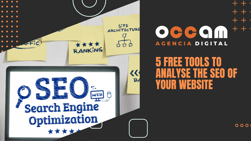Index Content
what do you need to know about SEO beforehand?
SEO is fundamentally about improving the positioning and visibility of a website in the organic results of the different search engines. In the case of Spain, Google accounts for 95% of all searches.
To understand the importance of being well positioned in search engine results, you need to know how the digital consumer thinks. Generally, nowadays, people use search engines to find any type of information, so it is important that your company is located in the top positions so that users can get to know you and thus generate a greater possibility of sales with respect to your competitors.
What you should know about SEO is that it is a set of activities, not a single one. The first aspects you should optimise are the accessibility and the content of your website.
Accessibility refers to how easy it is for users to find our website and what we have to offer. It is important for SEO to learn how to create intuitive interfaces so that each function or category of the website is easy to locate.
In order to have a good positioning and to make it easy to find our portal in the search monitors, it is important to offer quality content. This way we will correctly attend to the needs of the users.
Another feature to take into account is the optimisation of the portal's resources and formats in order to achieve a good performance of our portal avoiding the slowing down of the functions and making users abandon the website.
Once we have created a portal with good accessibility and good content, the next step is to learn how to position the website in the organic results of search engines. To do this, it is essential to use keywords, which are phrases or words that users use to consult information related to a topic they want information on.
List of tools to improve SEO.
In the case of SEO, to appear in the top positions of a search engine you do not have to pay for advertising campaigns. However, although it is free to use it, it can involve an economic cost, as well as time, to obtain a good positioning in Google. SEO has a great deal of work behind it to achieve the main objective. To place your business in the top positions of the search engine you must find the tools that best fit your marketing plan. That is why we are going to show you the best tools, both free and paid, to boost your positioning.
First of all, we will show you the best paid platforms:
- DinoRANK: in a single platform where you can work all the SEO of your website. The most remarkable thing about DinoRANK is that it is economical, it is all-in-one and it is easy to understand and use. One of its functions is that it allows you to see which keywords go up and down in all your tracked websites, globally and also, you can see a graph how all your keywords are fluctuating in Google. On the other hand, the platform allows you to detect all the errors on your website to correct them and thus optimise it.
- SERPStat: another tool that can also be considered an all-in-one tool, SERPStat provides you with SEO positioning data in Google search results but also allows you to see which pages have more visibility and who your main competitors are.
- SEO Powersuite: again, this is an SEO tool that covers several useful functions for positioning your website. It is very simple and intuitive to use, making it an appropriate tool for those who are starting out in the world of SEO. One of its main functions is its Rank Tracker, which allows you to check whether your website is moving up or down in the Google search results. You can also monitor the movements of the competition and obtain reports on your evolution and details to improve.
As alternative results, totally free of charge, we recommend:
- Rank Math: a free WordPress-specific SEO tool that helps you control the most basic aspects of your website's SEO, such as keyword usage and density, meta title and meta description customisation, metadata tagging and URL redirection.
- SERPSim: is a tool that shows you how your page will look in Google results. All you have to do is enter your title, meta description, and URL. It will tell you, for example, if your title and description are too long. It is a tool that analyses your posts to correct errors that could affect your ranking. You should resolve these errors to avoid problems in the search results.
- Google Rich Results Test: Google's rich results testing tool. Rich results offer experiences on Google services that give more information than standard blue links. Check the markup on your page to see if it is eligible for rich results generated by the structured data it contains.
how to measure the evolution of your positioning?
In a content strategy, analytics will be the one that tells us what works, what the user likes and how to continue growing. One of the points to bear in mind is that you must segment the traffic in order to know which pages of your website are the ones that work best and which ones can be improved.
At first glance it might seem that it is best to focus on the keywords that attract the most traffic, but these will have an established competition that will make it difficult to improve your positioning in Google.
Keyword ranking is certainly something that has lost a lot of importance since search results are becoming more and more personalised, but no matter how much relevance it has lost it is very useful to check keyword rankings to know the approximate positioning of the keywords we are optimising.
To find out which keywords attract traffic you can go to Google Webmaster Tools > Search Traffic > Search Queries. This tool will tell you the average position of the keywords that bring the most traffic to your website and the number of impressions and clicks.
It is important to take into account the experience of our users and know what is needed to offer a good experience and also know how to measure it. Knowing what your user needs you must get a product that is easy to use and with which the user can find what they are looking for. To achieve a good user experience you need to combine usability, design and SEO in a perfect way.
Web analytics is fundamental to evaluate the SEO actions of a plan.
The most widely used analytics tool is Google Analytics, which allows us to study our visits, clicks, which pages have more audience, which ones don't, social reports, among other functions. With Google Analytics we can see if people read our posts or if they have a high bounce rate.
Understanding and improving SEO is not something complex and inaccessible. Even a website without any SEO optimisation can also achieve an excellent natural positioning, as long as it has a good strategy. But it is important to take into account the advantages it offers us when it comes to improving our visualisation in Google.





